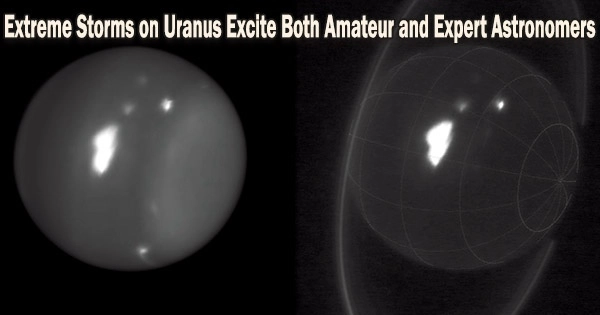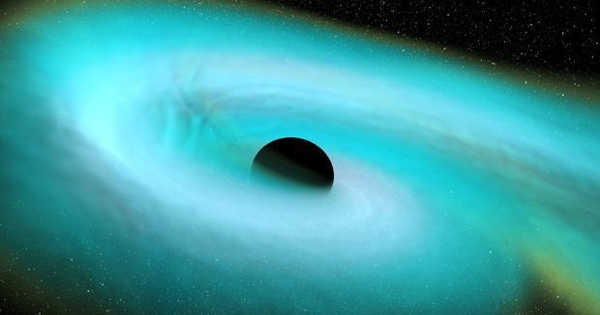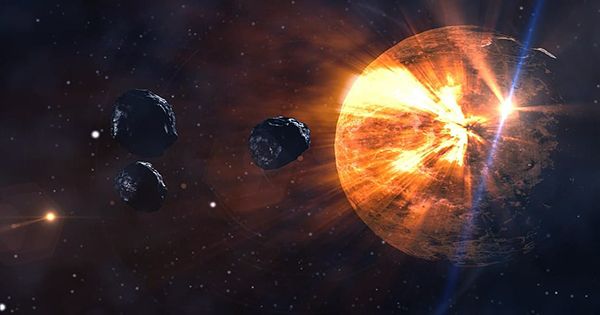For the first time ever, amateur astronomers are able to make out details in Uranus’ murky blue-green atmosphere because to the planet’s increasingly turbulent surface, which is covered in gigantic cloud complexes that are so dazzling.
“The weather on Uranus is incredibly active,” said Imke de Pater, professor and chair of astronomy at the University of California, Berkeley, and leader of the team that first noticed the activity when observing the planet with adaptive optics on the W. M. Keck Observatory in Hawaii.
“This type of activity would have been expected in 2007, when Uranus’s once-every-42-year equinox occurred and the sun shined directly on the equator,” noted co-investigator Heidi Hammel of the Association of Universities for Research in Astronomy. “But we predicted that such activity would have died down by now. Why we see these incredible storms now is beyond anybody’s guess.”
In all, de Pater, Hammel and their team detected eight large storms on Uranus’s northern hemisphere when observing the planet with the Keck Observatory on Aug. 5 and 6.
One of them was the brightest storm yet observed on Uranus at 2.2 microns, a wavelength that detects clouds just below the tropopause, the lower boundary of the stratosphere where pressure varies from around 300 to 500 mbar, about half that at the surface of the Earth. The storm was responsible for 30% of the planet’s overall light reflection at this wavelength.
Amateur astronomers were astounded to find a brilliant splotch on the planet’s normally dull blue dot’s surface when they pointed their telescopes on the planet after learning about the activity.
‘I got it!’
French amateur astronomer Marc Delcroix processed the amateur images and confirmed the discovery of a bright spot on an image by French amateur Régis De-Bénedictis, then in others taken by fellow amateurs in September and October. He had his own chance on Oct. 3 and 4 to photograph it with the Pic du Midi one-meter telescope, where on the second night, “I caught the feature when it was transiting, and I thought, ‘Yes, I got it!’” said Delcroix.
“I was thrilled to see such activity on Uranus. Getting details on Mars, Jupiter or Saturn is now routine, but seeing detail on Uranus and Neptune is the new frontier for us amateurs and I did not want to miss that,” said Delcroix, who works for an auto-parts supplier in Toulouse and has been observing the skies Jupiter in particular with his backyard telescope since 2006 and, since 2012, occasionally with the Pic du Midi telescope. “I was so happy to confirm myself these first amateur images on this bright storm on Uranus, feeling I was living a very special moment for planetary amateur astronomy.”
It’s interesting to note that the highly bright storm observed by the 10-meter Keck II telescope in the near infrared is not the same one that amateur astronomers observed because it can be found considerably deeper in the atmosphere.
This type of activity would have been expected in 2007, when Uranus’s once-every-42-year equinox occurred and the sun shined directly on the equator. But we predicted that such activity would have died down by now. Why we see these incredible storms now is beyond anybody’s guess.
Heidi Hammel
De Pater’s colleague Larry Sromovsky, a planetary scientist at the University of Wisconsin, Madison, identified the amateur spot as one of the few features on the Keck Observatory images from Aug. 5 that was only seen at 1.6 microns, and not at 2.2 microns. This feature is below the topmost cloud layer of methane ice in Uranus’s atmosphere because the 1.6-micron light is released from a deeper location in the atmosphere.
“The colors and morphology of this cloud complex suggests that the storm may be tied to a vortex in the deeper atmosphere similar to two large cloud complexes seen during the equinox,” Sromovsky said.
Similar vortices on Jupiter, especially its Great Red Spot, suggest that such vortices may be rooted considerably deeper in the atmosphere and span considerable vertical distances.
An expanded team of astronomers led by Kunio Sayanagi, an assistant professor at Hampton University in Virginia, leveraged the amateur observations to activate a “target of opportunity” proposal on the Hubble Space Telescope, which imaged the entire planet on Oct. 14. Observing at a variety of wavelengths, HST revealed multiple storm components extending over a distance of more than 9,000 kilometers (5,760 miles) and clouds at a variety of altitudes.
De Pater, Sromovsky, Hammel and Pat Fry of the University of Wisconsin will report the details of their observations on Nov. 12 at a meeting of the American Astronomical Society’s Division of Planetary Sciences in Tucson, Ariz.
Ice giant
An ice giant roughly four times the diameter of Earth, Uranus has an atmosphere primarily composed of hydrogen and helium, with a small amount of methane adding a hint of blue. Astronomers were able to discern little detail on its surface because it is so far away 19 times further from the sun than Earth until adaptive optics on both Keck Observatory telescopes discovered features similar to those on Jupiter.
Since more than a decade ago, De Pater and her colleagues have been tracking Uranus, monitoring the weather on the planet, including bands of circling clouds, enormous spinning storms, and convective features at its north pole. Gases like methane ascending in the atmosphere and condensing into highly reflecting clouds of methane ice are likely the cause of bright clouds.
It was once believed that Uranus’ atmosphere was entirely dependent on sunlight, which is now weak in the northern hemisphere, as the planet has no internal source of heat. Therefore, it came as a surprise to astronomers when these measurements revealed such tremendous activity.
Observations taken with the Keck telescope by Christoph Baranec, an assistant professor at the University of Hawaii on Manoa, revealed that the storm was still active, but had a different morphology and possibly reduced intensity.
“If indeed these features are high-altitude clouds generated by flow perturbations associated with a deeper vortex system, such drastic fluctuations in intensity would indeed be possible,” Sromovsky said.
“These unexpected observations remind us keenly of how little we understand about atmospheric dynamics in outer planet atmospheres,” the authors wrote in their paper.
















